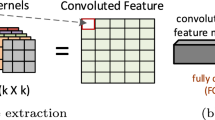Abstract
We present an implementation of an improved adder via a spiking neural P system. Our adder processes arbitrary length binary numbers, and thus, is suitable for cryptographic applications. Due to the use of dual-rail logic, the adder is also error tolerant. We present the implementation concept, as well as a simulation model in System-C.






Similar content being viewed by others
References
Chen, H., Ionescu, M., & Ishdorj, T.O. (Jun 2006) On the Efficiency of Spiking Neural P Systems. In: Proceedings of 8th International Conference on Electronics, Information, and Communication (ICEIC 2006), Ulaanbaatar, Mongolia (pp. 49–52).
Haiming, C., Ishdorj, T. O., & Păun, G. (2007). Computing along the axon. Progress in Natural Science, 17(4), 417–423. https://doi.org/10.1080/10020070708541018.
Ionescu, M., Păun, A., Păun, G., & Pérez-Jiménez, M.J. (2006). Computing with spiking neural p systems: Traces and small universal systems. In: C. Mao & T. Yokomori (Eds.), DNA Computing. DNA 2006. Lecture Notes in Computer Science. Berlin: Springer (vol. 4287, no. 16, pp. 1–16). https://doi.org/10.1007/11925903_1
Ionescu, M., Păun, G., & Yokomori, T. (2006). Spiking neural P systems. Fundamenta Informaticae, 71(2), 279–308.
Ishdorj, T. O., & Leporati, A. (2008). Uniform solutions to SAT and 3-SAT by spiking neural P systems with pre-computed resources. Natural Computing, 7(4), 519–534. https://doi.org/10.1007/s11047-008-9081-0.
Ishdorj, T. O., Leporati, A., Pan, L., & Zeng, X. (2010). Deterministic solutions to QSAT and Q3SAT by spiking neural P systems with pre-computed resources. Theoretical Computer Science, 411(25), 2345–2358. https://doi.org/10.1016/j.tcs.2010.01.019.
Ishdorj, T.O., Ochirbat, O., & Naimannaran, C. (2019). A \(\mu\)-fluidic biochip design for spiking neural P systems. International Journal of Unconventional Computation (accepted).
Krambeck, R. H., Lee, C. M., & Law, H. S. (1982). High-speed compact circuits with CMOS. IEEE Journal of Solid-State Circuits, 17(3), 614–619. https://doi.org/10.1109/JSSC.1982.1051786.
Ledesma, L., Manrique, D., & Rodríguez-Patón, A. (2005). A tissue P system and a DNA microfluidic device for solving the shortest common superstring problem. Soft Computing, 9(9), 679–685. https://doi.org/10.1007/s00500-004-0398-z.
Paun, G., Rozenberg, G., & Salomaa, A. (2010). The oxford handbook of membrane computing. Oxford: Oxford University Press Inc.
Weste, N. H. E., & Eshraghian, K. (1985). Principles of CMOS VLSI design: A systems perspective. Boston: Addison-Wesley Longman Publishing Co. Inc.
Xu, Z., Cavaliere, M., An, P., Vrudhula, S., & Cao, Y. (2014). The stochastic loss of spikes in spiking neural P systems: Design and implementation of reliable arithmetic circuits. Fundamenta Informaticae, 134(1–2), 183–200. https://doi.org/10.3233/FI-2014-1098.
Acknowledgements
This work has been supported by the Mongolian Foundation for Science and Technology (Research Grants ShUSS-2018/04 and MOST-MECSS2017001), and the School of Information and Communication Technology, MUST (Research Grant SICT201801). This work has been presented at the 20th Conference on Membrane Computing in Curtea de Arges, Romania, August 5–8, 2019.
Author information
Authors and Affiliations
Corresponding author
Ethics declarations
Conflict of interest
On behalf of all authors, the corresponding author states that there is no conflict of interest.
Additional information
Publisher's Note
Springer Nature remains neutral with regard to jurisdictional claims in published maps and institutional affiliations.
Rights and permissions
About this article
Cite this article
Ochirbat, O., Ishdorj, TO. & Cichon, G. An error-tolerant serial binary full-adder via a spiking neural P system using HP/LP basic neurons. J Membr Comput 2, 42–48 (2020). https://doi.org/10.1007/s41965-020-00033-3
Received:
Accepted:
Published:
Issue Date:
DOI: https://doi.org/10.1007/s41965-020-00033-3




